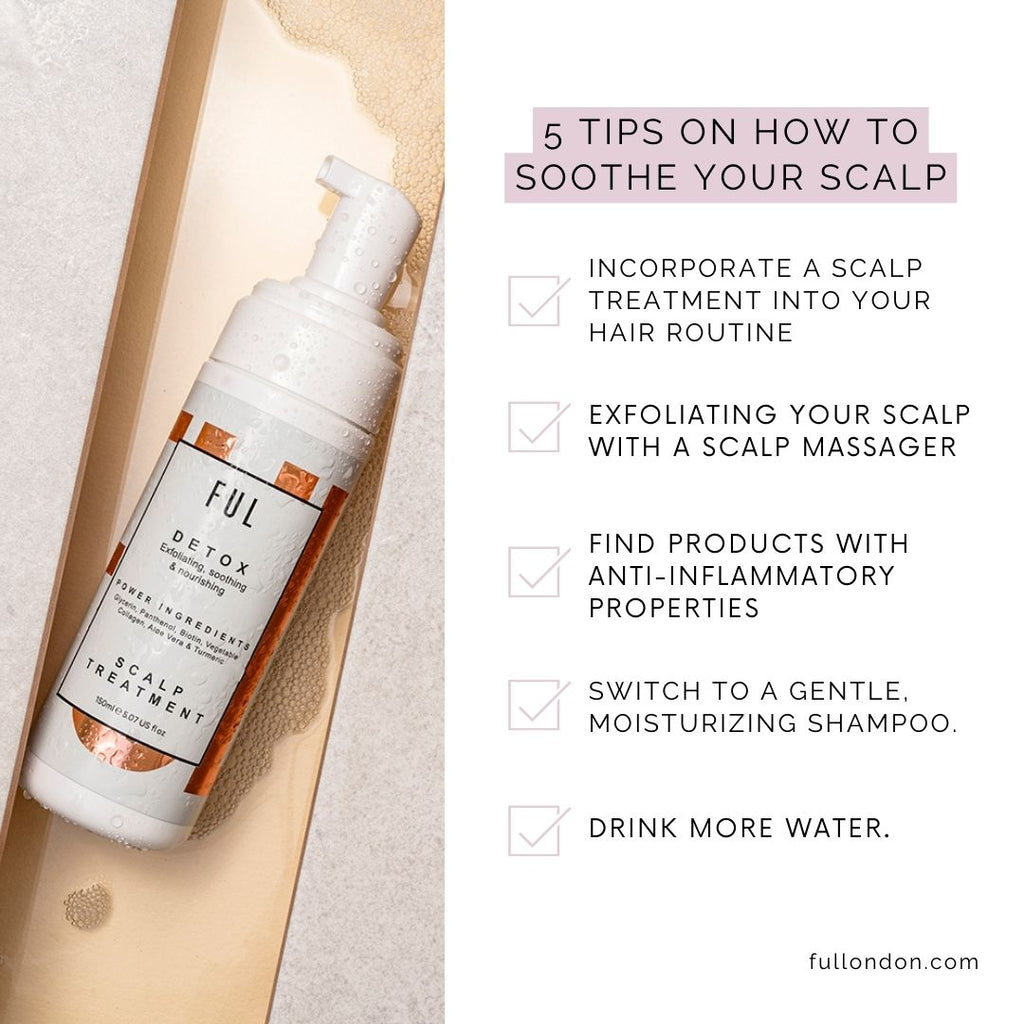A flaky scalp and persistent itchiness can be frustrating. Many people confuse dry scalp with dandruff, but while both involve visible flakes and discomfort, they have different causes and require different care. Knowing how to tell them apart helps you find the right solution and keep your scalp comfortable and balanced. This guide explains the causes, symptoms, treatments, and prevention tips so you can identify your scalp concern with confidence.
What Is Dry Scalp?
A dry scalp develops when the skin on your head doesn’t produce or retain enough natural oils. Without this protective layer of moisture, the scalp becomes tight, itchy, and sheds small, fine flakes. Unlike dandruff, which is linked to oil and yeast overgrowth, dry scalp is typically the result of dehydration, external factors, or overly harsh routines that strip away natural oils.
Common Causes of Dry Scalp
Dry scalp can appear for many reasons, and often more than one factor plays a role:
1. Cold, dry air or extreme weather
Winter months and low humidity environments can quickly sap moisture from the skin.
2. Over-washing or frequent heat styling
Excessive shampooing, blow-drying, or heat tool use can weaken the scalp’s natural barrier.
3. Harsh haircare products
Sulphate-heavy shampoos, strong styling sprays, or alcohol-based products can strip essential oils.
4. Lifestyle factors
Dehydration, smoking, or a diet lacking in omega-3 fatty acids may all contribute.
5. Underlying skin sensitivity
People with eczema or psoriasis often experience dryness on the scalp as well as the body.
6. Natural aging
Oil production slows down with age, making dryness more common in mature scalps.
Symptoms of Dry Scalp
The signs of dry scalp usually extend beyond just flaking:
-
Small, fine, white flakes that often fall off easily when brushing or scratching.
-
Tightness or itching that feels worse after washing with hot water or using styling products.
-
Dry patches in multiple areas such as the scalp, eyebrows, sides of the nose, or behind the ears.
-
Increased sensitivity where the scalp feels tender or reacts strongly to certain shampoos.
-
Hair that looks dull or brittle due to lack of natural oil at the root.
What Is Dandruff?
Dandruff is a chronic scalp condition marked by the shedding of larger, oilier flakes that are often yellow or white in appearance. Unlike dry scalp, which is caused by a lack of moisture, dandruff is generally linked to excess oil production, yeast overgrowth, and inflammation. It can be stubborn, recurring, and in many cases requires targeted treatment rather than simple moisturisation.
Common Causes of Dandruff
Several underlying factors can trigger or worsen dandruff:
-
Seborrheic dermatitis – a common condition that causes greasy, red, scaly patches on the scalp.
-
Overgrowth of Malassezia yeast – this naturally occurring fungus can multiply excessively, leading to rapid skin cell turnover and flaking.
-
Chronic skin conditions – eczema, psoriasis, and other inflammatory disorders can mimic or worsen dandruff.
-
Stress and hormonal fluctuations – both can alter scalp oil production and weaken the skin barrier.
-
Environmental and lifestyle triggers – such as infrequent hair washing, poor scalp hygiene, or heavy product buildup.
Symptoms of Dandruff
The signs of dandruff are usually more pronounced than those of dry scalp:
-
Large, oily flakes that may appear yellowish or stick to the scalp and hair.
-
Persistent itchiness that does not ease with simple moisturisers.
-
Red, inflamed, or greasy scalp that feels irritated and sensitive.
-
Flakes on clothing or shoulders that often reappear quickly even after washing.
-
Scalp discomfort that may worsen in stressful periods or during seasonal changes.
Dry Scalp vs. Dandruff: Key Differences
|
Feature |
Dry Scalp |
Dandruff |
|
Flake Size |
Small, fine |
Large, oily |
|
Scalp Appearance |
Tight, dry |
Red, oily, scaly |
|
Itchiness |
Mild to moderate |
Often intense |
|
Spread |
Can affect other dry skin areas |
Primarily scalp |
|
Cause |
Lack of moisture |
Excess oil and yeast |
Tip: Apply a light moisturizer before bed. If flakes disappear after washing, it is likely dry scalp.
How to Treat Dry Scalp
The best approach to treating dry scalp is to restore moisture and protect the skin barrier while avoiding anything that strips away natural oils. Here are some proven ways to manage it:
1. Use a Gentle, Hydrating Shampoo
Choosing the right shampoo is essential for a dry scalp. Opt for gentle, sulphate-free formulas that cleanse without stripping your scalp of natural oils. This keeps your scalp soft, comfortable, and less prone to flaking.
2. Incorporate a Weekly Scalp Treatment
A gentle scalp treatment can help remove buildup from styling products and environmental debris. Doing this once or twice a week gives your scalp a fresh start and allows moisturising treatments to work more effectively.
3. Lock in Hydration
Even dry scalps need hydration. Lightweight serums or leave-in treatments with water-binding ingredients can soothe tightness, reduce itchiness, and keep flakes at bay without weighing hair down.
4. Support from the Inside
Healthy habits make a real difference. Drink plenty of water, include omega-3-rich foods like salmon, walnuts, or flaxseeds in your diet, and limit excessive heat styling to prevent further moisture loss.
How to Manage Dandruff
Dandruff care focuses on reducing yeast overgrowth, controlling excess oil, and calming inflammation. These steps are commonly recommended:
1. Wash Regularly with an Anti-Dandruff Shampoo
Using a shampoo formulated for dandruff helps control yeast overgrowth and reduces flaking. Look for ingredients like zinc pyrithione, ketoconazole, or salicylic acid, which target the root causes of dandruff.
2. Clarify the Scalp Occasionally
Removing excess oil and product buildup prevents yeast from thriving. Gentle clarifying treatments once in a while can restore balance without over-drying your scalp.
3. Keep the Scalp Balanced
Even if your scalp feels oily, hydration is still important. Lightweight, water-based serums or soothing aloe-based formulas can maintain comfort and prevent rebound dryness.
4. Address Lifestyle Triggers
Stress, lack of sleep, and hormonal changes can worsen dandruff. Practicing relaxation techniques, getting adequate rest, and enjoying some safe sun exposure can help keep flare-ups under control.
Prevention Tips for a Healthy Scalp
To maintain a healthy scalp and prevent flakes from returning, here is how you can care for your scalp:
1. Care for Your Scalp Consistently
Maintaining a healthy scalp requires a consistent routine. Using gentle, scalp-friendly products regularly helps prevent flakes from returning and keeps the skin balanced.
2. Avoid Harsh Chemicals and Heavy Oils
Hair products that contain alcohol, bleach, or heavy oils can block follicles and irritate the scalp. Choose lightweight, nourishing formulations that support scalp health without buildup.
3. Wash Hair Regularly
Keeping the scalp clean is essential. Regular washing with a gentle or anti-flake shampoo removes excess oil, sweat, and environmental debris, helping prevent irritation and flaking.
4. Keep the Scalp Hydrated
Hydration is key to long-term scalp health. Moisturising treatments, lightweight serums, and a balanced diet support hydration from both inside and out, reducing dryness and itchiness.
When to See a Doctor
If flakes persist, worsen, or are accompanied by redness, swelling, or pain, it’s time to consult a dermatologist. Persistent scalp issues may be a sign of eczema, psoriasis, or fungal infections that need professional care. Early evaluation ensures the right treatment and prevents long-term discomfort.
Final Thoughts
Dry scalp and dandruff can look very similar, but they happen for different reasons. Knowing what’s causing your flakes is the first step toward a comfortable, healthy scalp. FUL offers a full range of scalp care products designed to help with these concerns. Gentle cleansing, deep hydration, and targeted treatments work together to calm irritation, balance the scalp, and keep your hair strong and shiny. With consistent care, you can enjoy a flake-free, nourished scalp and hair that feels healthy and looks great.
Ready to give your scalp the care it deserves? Check out FUL’s scalp care range and find the products that fit perfectly into your routine.
FAQs: Dry Scalp vs Dandruff
How can I tell if my scalp is dry or I have dandruff?
Dry scalp usually produces small, fine flakes, and the scalp feels tight. Dandruff produces larger, oilier flakes with possible redness and inflammation.
Can stress cause dandruff?
Yes, stress can trigger hormonal changes that worsen dandruff and increase flaking.
How often should I wash my hair if I have a dry scalp?
Wash with a gentle, moisturizing shampoo 2–3 times per week or as needed to prevent stripping natural oils.
Can diet affect scalp health?
Absolutely. A diet rich in essential fatty acids, proteins, and hydration supports scalp moisture and reduces dryness.
Will using scalp treatments make my hair oily?
When used as directed, scalp treatments hydrate and balance the scalp without making hair greasy.


